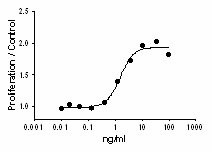- Regulatory Status
- RUO
- Other Names
- Interleukin-7, Lymphopoietin-1 (LP-1), Pre-B cell growth factor, Thymocyte growth factor

-

PHA activated PBL proliferation induced by mouse IL-7.
| Cat # | Size | Price | Quantity Check Availability | ||
|---|---|---|---|---|---|
| 577802 | 10 µg | $218.00 | |||
| 577804 | 25 µg | $382.00 | |||
| 577806 | 100 µg | $1073.00 | |||
| 577808 | 500 µg | $3065.00 | |||
Mouse IL-7 was initially described as a pre B-cell growth factor expressed in bone marrow stromal cells. IL-7 is essential for normal murine B cell development, and plays a key role in regulating the homeostasis and function of the T-cells. The binding of IL-7 to its receptor induces dimerization of IL-7Ra and the common gamma chain (gc) which leads to activation of receptor associated tyrosine Janus kinases JAK1 (IL-7R) and JAK3 (γc). The activated JAK proteins in turn phosphorylate specific residues on the IL-7R creating docking sites for signaling molecules such as STAT5 and to a lesser extent STAT1 and STAT3. In adult mice, IL-7/IL-7R signaling up regulates expression of early B cell factor (EBF), and EBF in turn regulates expression of B cell-specific genes required for the transition from lymphoid progenitor to pro-B cells. Besides, IL-7 plays a role in the development of secondary lymphoid tissues. IL-7 is necessary to specify CD8 lineage differentiation during CD4/CD8 cell fate choice in the thymus by inducing expression of the transcription factor Runx3. IL-7 induces anti-apoptotic factors Bcl2 and Bcl-xL and inhibiting pro-apoptotic factors such as Bad and Bax. In this fashion, IL-7 induces cell activation, survival, and proliferation of T lymphocytes. In addition, IL-7 controls T-cell size and metabolism through the activation of PI3 kinase-dependent pathways and regulation of glucose metabolism. IL-7 also controls T cell–dendritic cell interactions that are essential for both T-cell homeostasis and activation in vivo. CD4 T cell lymphopenia increases the expression of circulating IL-7, and TGFb induces IL-7 downregulation.
Product Details
- Source
- Mouse IL-7, amino acids Glu26 -Ile154 (Accession# NM_008371.4) was expressed in insect cells.
- Molecular Mass
- The 148 amino acid recombinant protein (with ADL-His9-SSGIEGR at N-terminus) has a predicted molecular mass of approximately 17 kD. The DTT-reduced and non-reduced protein migrates at approximately 20 kD by SDS-PAGE.
- Purity
- >95%, as determined by Coomassie stained SDS-PAGE.
- Formulation
- The protein was 0.22 µm filtered in 10 mM NaH2PO4, 150 mM NaCl, pH 7.2.
- Endotoxin Level
- Less than 0.01 ng per µg cytokine as determined by the LAL method.
- Concentration
- 10 and 25 µg sizes are bottled at 100 µg/mL. 100 µg size and larger sizes are lot-specific and bottled at the concentration indicated on the vial. To obtain lot-specific concentration and expiration, please enter the lot number in our Certificate of Analysis online tool.
- Storage & Handling
- Unopened vial can be stored between 2°C and 8°C for up to 2 weeks, at -20°C for up to six months, or at -70°C or colder until the expiration date. For maximum results, quick spin vial prior to opening. The protein can be aliquoted and stored at -20°C or colder. Stock solutions can also be prepared at 50 - 100 µg/mL in appropriate sterile buffer, carrier protein such as 0.2 - 1% BSA or HSA can be added when preparing the stock solution. Aliquots can be stored between 2°C and 8°C for up to one week and stored at -20°C or colder for up to 3 months. Avoid repeated freeze/thaw cycles.
- Activity
- ED50 =1.0 - 5 ng/ml, corresponding to a specific activity of 0.2 - 1 x 106 units/mg, as determined by PHA activated PBL proliferation induced by IL-7 in a dose dependent manner. Under this condition the bioactivity is equivalent
- Application
-
Bioassay
- Application Notes
-
BioLegend carrier-free recombinant proteins provided in liquid format are shipped on blue-ice. Our comparison testing data indicates that when handled and stored as recommended, the liquid format has equal or better stability and shelf-life compared to commercially available lyophilized proteins after reconstitution. Our liquid proteins are verified in-house to maintain activity after shipping on blue ice and are backed by our 100% satisfaction guarantee. If you have any concerns, contact us at tech@biolegend.com.
- Product Citations
-
Antigen Details
- Structure
- Cytokine
- Distribution
-
Thymic and bone morrow stromal cells, keratinocytes, dendritic cells, endothelial cells, intestinal epithelial, and epithelial goblet cells.
- Function
- IL-7 is essential for B cell production.
- Interaction
- Progenitor B and T cells, CD4-CD8- thymocytes, naïve and memory CD4 and CD8 T cells, and megakaryocytes.
- Ligand/Receptor
- Heterodimer IL-7Rα (CD127); γ-subunit (CD132) which shares component with IL-2, IL-4, IL-13, IL-15, and IL-21 receptors.
- Cell Type
- B cells, Hematopoietic stem and progenitors
- Biology Area
- Immunology, Stem Cells
- Molecular Family
- Cytokines/Chemokines
- Antigen References
-
1. Yokota T, et al. 1986. P. Natl. Acad. Sci. USA 83:5894.
2. Meier D, et al. 2007. Immunity 26:643.
3. Parish JK, et al. 2009 J. Immunol. 182:4255.
4. Saini M, et al. 2009. Blood 113:5793.
5. Park JH, et al. 2010. Nat. Immunol. 11:257.
6. Li WQ, et al. 2010. Mol. Cell. Biol. 30:590. - Gene ID
- 16196 View all products for this Gene ID
- UniProt
- View information about IL-7 on UniProt.org
